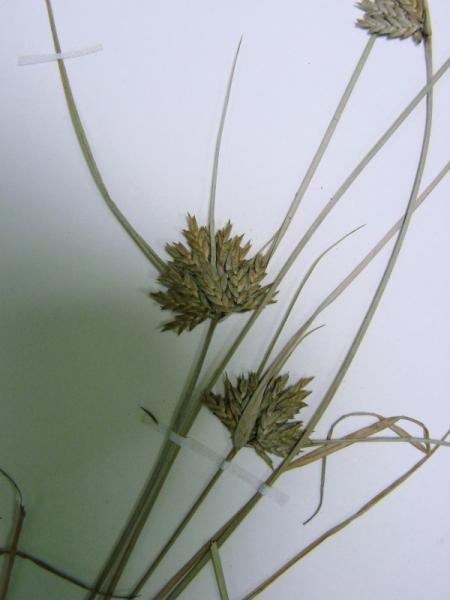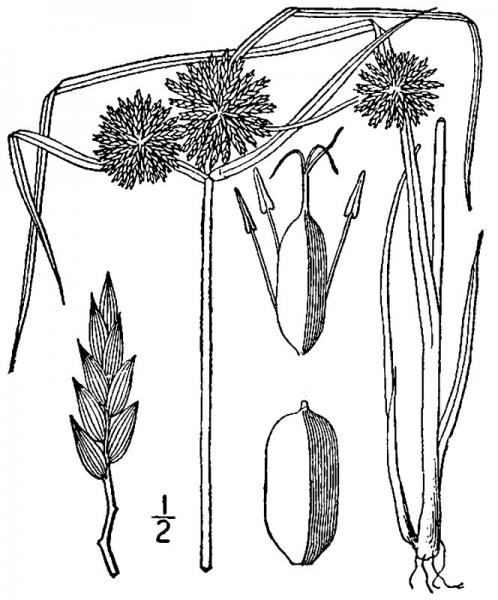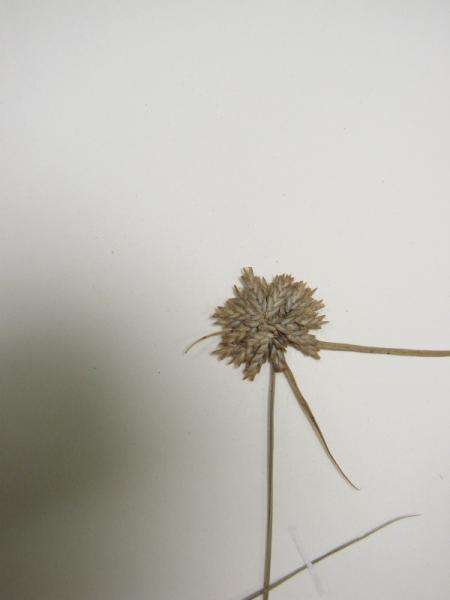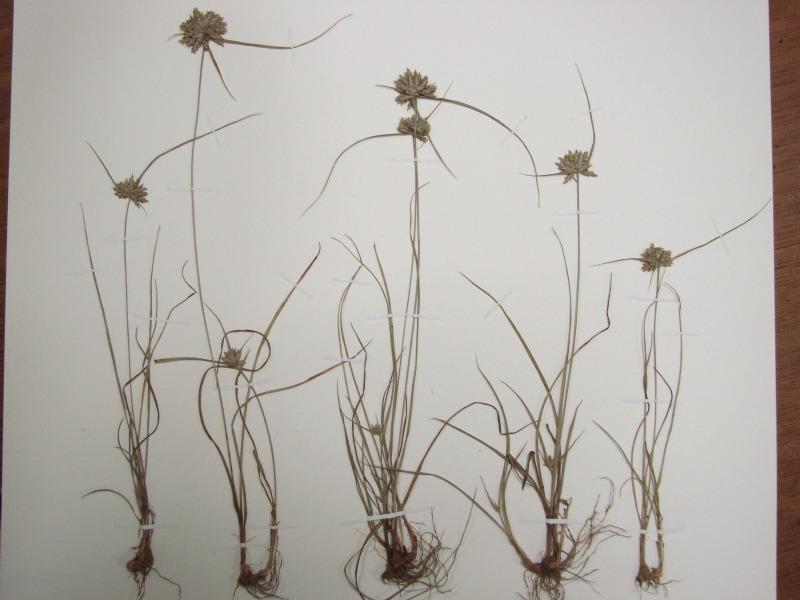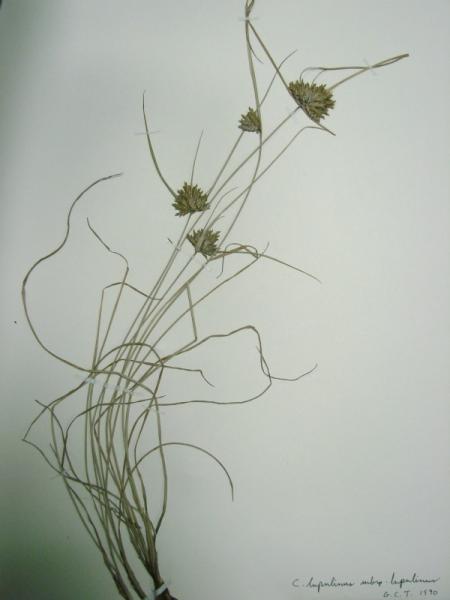Great Plains Flat Sedge
Cyperus lupulinus ssp. lupulinus None
- Class
- Monocotyledoneae (Monocots)
- Family
- Cyperaceae (Sedge Family)
- State Protection
- Threatened
Listed as Threatened by New York State: likely to become Endangered in the foreseeable future. For animals, taking, importation, transportation, or possession is prohibited, except under license or permit. For plants, removal or damage without the consent of the landowner is prohibited.
- Federal Protection
- Not Listed
- State Conservation Status Rank
- S3
Vulnerable in New York - Vulnerable to disappearing from New York due to rarity or other factors (but not currently imperiled); typically 21 to 80 populations or locations in New York, few individuals, restricted range, few remaining acres (or miles of stream), and/or recent and widespread declines.
- Global Conservation Status Rank
- G5T5?
Secure globally (most likely) - Conservation status of the subspecies/variety is uncertain, but is most likely common in the world; widespread and abundant (but may be rare in some parts of its range). More information is needed to assign a firm conservation status. (The species as a whole is common globally.)
Summary
Did you know?
A good way to remember that the scales of this subspecies are more loosely arranged around the fruit than the closely related Cyperus lupulinus ssp. macilentus, which has scales that tightly clasp the fruit, is that the name lupulinus refers to the hop genus Lupulus which has inflated fruits. This subspecies may be undercollected because it very closely resembles the common subspecies macilentus.
State Ranking Justification
There are seventeen existing populations but most of them are from specimens identified after collections took place so there is no detailed information about their locations or populations. There are 15 historical populations that have not been actively surveyed.
Short-term Trends
Not enough survey work has been done to understand short-term trends.
Long-term Trends
Long-term trends are not yet fully understood. There are about 15 historical records mostly from Long Island but not enough survey work has been done to relocate these occurrences nor to understand how common this species is now.
Conservation and Management
Threats
The species occurs in open sandy environments which are often used for recreation or development but not enough survey work has been done to fully understand current threats.
Conservation Strategies and Management Practices
The open sandy habitat where this species grows needs to be protected from development and maintained in its open condition by preventing succession.
Research Needs
More herbarium work is needed to check specimens for correct identification. Habitat preference should be studied to understand why this species is not more common in a habitat that is common on Long Island. A search image needs to be refined to better locate this species among its closely related taxa.
Habitat
Habitat
More information on this species' habitat requirements is needed. In New York it has been collected from sandy soils at beaches, railroads, roadsides, and pastures (New York Natural Heritage Program 2007). Dry woods and fields (Gleason and Cronquist 1991).
Associated Ecological Communities
- Construction/road maintenance spoils
A site where soil from construction work and/or road maintenance materials have been recently deposited. There is little, if any, vegetation.
- Pastureland
Agricultural land permanently maintained (or recently abandoned) as a pasture area for livestock.
- Railroad
A permanent road having a line of steel rails fixed to wood ties and laid on a gravel roadbed that provides a track for cars or equipment drawn by locomotives or propelled by self-contained motors. There may be sparse vegetation rooted in the gravel substrate. The railroad right of way may be maintained by mowing or herbicide spraying.
- Sand beach
A sparsely vegetated community that occurs on unstable sandy shores of large freshwater lakes, where the shore is formed and continually modified by wave action and wind erosion. Characteristic species that are usually present at very low percent cover include various grasses and other herbs.
Associated Species
- Ammophila breviligulata (beach grass)
- Cakile edentula
- Chamaesyce polygonifolia
- Euphorbia po
- Hudsonia tomentosa (beach-heather)
- Lechea mucronata (hairy pinweed)
- Salsola kali
- Solidago sempervirens (northern seaside goldenrod)
Range
New York State Distribution
In New York most collections of this species are from Long island, with a few collections from the Hudson Valley to as far north as Albany County.
Global Distribution
Great Plains flatsedge is found from Massachusetts through the Upper Midwest and Ontario, as far west as Minnesota, and south to North Carolina to , extending west to Texas, Missouri and Colorado. It is also disjunct to Oregon and Idaho.
Identification Comments
General Description
Great Plains flatsedge is a perennial flatsedge that grows from short tuberous rhizomes, from 1 to 5 dm tall. It has thin (.8-3.5 mm) leaves and a crowded, round, sessile spike. The leaves and bracts have scabrous margins. The spikelets are flattened and 2.5 to 5mm wide, and the achenes are trigonous, 1.4 to 2.2mm long, and about half as wide.
Best Life Stage for Proper Identification
Fruiting individuals are needed to identify this plant.
Similar Species
The other subspecies of Cyperus lupulinus, C. luplinus ssp. macilentus, is more widely distributed in New York, has 3-7 floral scales whose margins clasp the achenes, whereas C.lupulinus ssp. lupulinus has 5 -22 floral scales, not touching the achenes. C. hougtonii and C. schweinitzii each tend to have shorter achenes and scales (Voss 1972).
Best Time to See
This species fruits in late July, the fruits persistent into fall.
- Fruiting
The time of year you would expect to find Great Plains Flat Sedge fruiting in New York.
Great Plains Flat Sedge Images
Taxonomy
Great Plains Flat Sedge
Cyperus lupulinus ssp. lupulinus None
- Kingdom Plantae
- Phylum Anthophyta
- Class Monocotyledoneae
(Monocots)
- Order Cyperales
- Family Cyperaceae (Sedge Family)
- Order Cyperales
- Class Monocotyledoneae
(Monocots)
- Phylum Anthophyta
Additional Common Names
- Cyperus
- Flat Sedge
- Great Plains Flatsedge
Synonyms
- Cyperus filiculmis auct. non Vahl
Additional Resources
Best Identification Reference
Flora of North America Editorial Committee. 2002. Flora of North America, North of Mexico. Volume 23. Magnoliophyta: Commelinidae (in part): Cyperaceae. Oxford University Press, New York. 608 pp.
Other References
Gleason, Henry A. and A. Cronquist. 1991. Manual of Vascular Plants of Northeastern United States and Adjacent Canada. The New York Botanical Garden, Bronx, New York. 910 pp.
Holmgren, Noel. 1998. The Illustrated Companion to Gleason and Cronquist's Manual. Illustrations of the Vascular Plants of Northeastern United States and Adjacent Canada. The New York Botanical Garden, Bronx, New York.
New York Natural Heritage Program. 2010. Biotics database. New York Natural Heritage Program. New York State Department of Environmental Conservation. Albany, NY.
New York Natural Heritage Program. 2024. New York Natural Heritage Program Databases. Albany, NY.
Voss, E.G. 1972. Michigan Flora, Part I. Gymnosperms and Monocots. Cranbrook Institute of Science Bulletin 55 and the University of Michigan Herbarium. Ann Arbor. 488 pp.
Weldy, T. and D. Werier. 2010. New York flora atlas. [S.M. Landry, K.N. Campbell, and L.D. Mabe (original application development), Florida Center for Community Design and Research http://www.fccdr.usf.edu/. University of South Florida http://www.usf.edu/]. New York Flora Association http://newyork.plantatlas.usf.edu/, Albany, New York
Weldy, Troy W. and David Werier. 2005. New York Flora Atlas. [S.M. Landry, K.N. Campbell, and L.D. Mabe (original application development), Florida Center for Community Design and Research. University of South Florida]. New York Flora Association, Albany, NY. Available on the web at (http://newyork.plantatlas.usf.edu/).
Werier, David, Kyle Webster, Troy Weldy, Andrew Nelson, Richard Mitchell†, and Robert Ingalls†. 2022 New York Flora Atlas. [S. M. Landry and K. N. Campbell (original application development), USF Water Institute. University of South Florida]. New York Flora Association, Albany, New York.
Links
About This Guide
Information for this guide was last updated on: January 18, 2008
Please cite this page as:
New York Natural Heritage Program. 2024.
Online Conservation Guide for
Cyperus lupulinus ssp. lupulinus.
Available from: https://guides.nynhp.org/great-plains-flatsedge/.
Accessed July 27, 2024.
